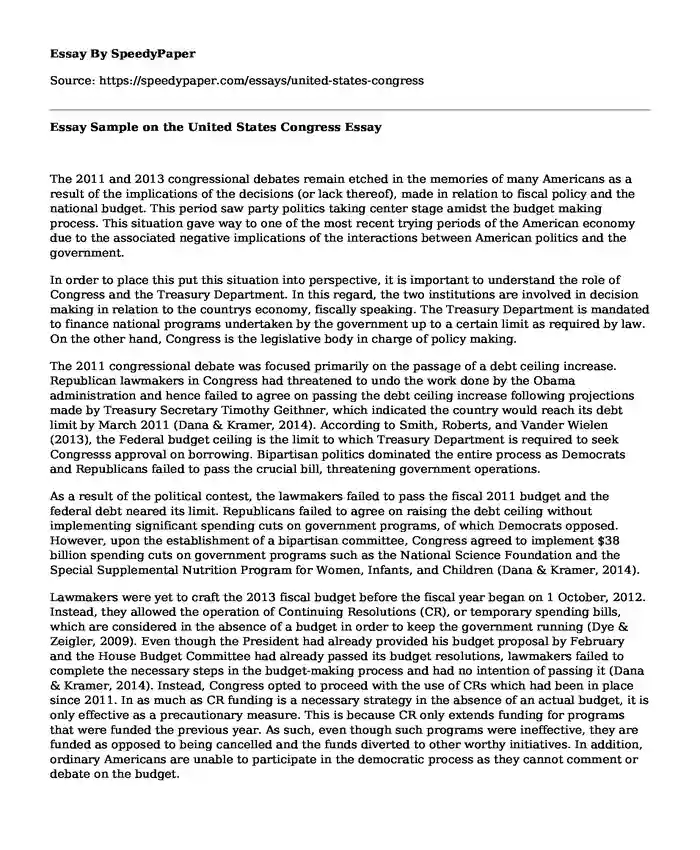
| Type of paper: | Essay |
| Categories: | Politics United States Political science |
| Pages: | 3 |
| Wordcount: | 680 words |
The 2011 and 2013 congressional debates remain etched in the memories of many Americans as a result of the implications of the decisions (or lack thereof), made in relation to fiscal policy and the national budget. This period saw party politics taking center stage amidst the budget making process. This situation gave way to one of the most recent trying periods of the American economy due to the associated negative implications of the interactions between American politics and the government.
In order to place this put this situation into perspective, it is important to understand the role of Congress and the Treasury Department. In this regard, the two institutions are involved in decision making in relation to the countrys economy, fiscally speaking. The Treasury Department is mandated to finance national programs undertaken by the government up to a certain limit as required by law. On the other hand, Congress is the legislative body in charge of policy making.
The 2011 congressional debate was focused primarily on the passage of a debt ceiling increase. Republican lawmakers in Congress had threatened to undo the work done by the Obama administration and hence failed to agree on passing the debt ceiling increase following projections made by Treasury Secretary Timothy Geithner, which indicated the country would reach its debt limit by March 2011 (Dana & Kramer, 2014). According to Smith, Roberts, and Vander Wielen (2013), the Federal budget ceiling is the limit to which Treasury Department is required to seek Congresss approval on borrowing. Bipartisan politics dominated the entire process as Democrats and Republicans failed to pass the crucial bill, threatening government operations.
As a result of the political contest, the lawmakers failed to pass the fiscal 2011 budget and the federal debt neared its limit. Republicans failed to agree on raising the debt ceiling without implementing significant spending cuts on government programs, of which Democrats opposed. However, upon the establishment of a bipartisan committee, Congress agreed to implement $38 billion spending cuts on government programs such as the National Science Foundation and the Special Supplemental Nutrition Program for Women, Infants, and Children (Dana & Kramer, 2014).
Lawmakers were yet to craft the 2013 fiscal budget before the fiscal year began on 1 October, 2012. Instead, they allowed the operation of Continuing Resolutions (CR), or temporary spending bills, which are considered in the absence of a budget in order to keep the government running (Dye & Zeigler, 2009). Even though the President had already provided his budget proposal by February and the House Budget Committee had already passed its budget resolutions, lawmakers failed to complete the necessary steps in the budget-making process and had no intention of passing it (Dana & Kramer, 2014). Instead, Congress opted to proceed with the use of CRs which had been in place since 2011. In as much as CR funding is a necessary strategy in the absence of an actual budget, it is only effective as a precautionary measure. This is because CR only extends funding for programs that were funded the previous year. As such, even though such programs were ineffective, they are funded as opposed to being cancelled and the funds diverted to other worthy initiatives. In addition, ordinary Americans are unable to participate in the democratic process as they cannot comment or debate on the budget.
As demonstrated above in relation to the relationship between the United States Congress and the Treasury Department, politics take center stage. In the process, the American people end up getting hurt as a result of rising unemployment, high inflation, and costly interest rates, as happened during the 16-days government shutdown in 2013. In this regard, lawmakers should cease from engaging in petty politics when the nation is dependent on their choices and actions, for the sake of the American people.
References
Dana, S. & Kramer, M. (2014). History of the U.S Federal Budget, 2011-2013. National Priorities Project. Retrieved from https://www.nationalpriorities.org/analysis/2014/history-us-federal-budget-2011-2013/
Dye, T. R., & Zeigler, L. H. (2009). The irony of democracy: An uncommon introduction to American politics. Boston: Wadsworth Cengage Learning.
Smith, S., Roberts, J., & Vander Wielen, R. (2013). The American Congress. New York: Cambridge University Press.
Cite this page
Essay Sample on the United States Congress. (2019, Nov 18). Retrieved from https://speedypaper.net/essays/united-states-congress
Request Removal
If you are the original author of this essay and no longer wish to have it published on the SpeedyPaper website, please click below to request its removal:
- Free Essay on Project Management Competencies
- B. F. Skinner's Radical Behaviorism, Free Essay in Psychology
- A Theoretical Approach of Different Authors on Reality TV, the Media, and News
- Essay Example for Everyone: Main Principles of Marketing Mix
- Essay Example on Media and Aggression in Young People
- Essay Sample on Examining Joris Luyendijk's Text
- Free Report: Differences between Engineering and Administrative Controls
Popular categories




